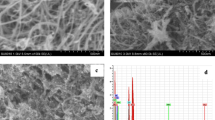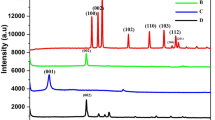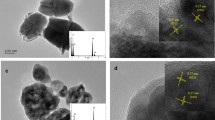Abstract
In this work, we reported the highly ordered NiCo2O4 nanoneedle@polypyrrole arrays anchored on three-dimensional graphene (NiCo2O4@PPy/3D graphene) for high-sensitivity detection of trace lead ions (Pb2+). The 3D graphene was prepared by a hydrothermal process and then decorated with NiCo2O4 nanoneedle arrays by another hydrothermal process. This two-step hydrothermal method is simple and mild. Furthermore, the highly conductive PPy was coated on NiCo2O4 via a chemical vapor-phase polymerization to prepare NiCo2O4@PPy/3D graphene. The free-standing NiCo2O4@PPy/3D graphene can be directly utilized as 3D electrochemical working electrode without being decorated onto working electrode like Au and glassy carbon electrode. High conductivity, large specific surface area, short ion diffusion path and excellent adsorption capacity of NiCo2O4@PPy/3D graphene efficiently improved electrochemical property for the detection of Pb2+. Using square-wave anodic stripping voltammetry (SWASV), a linear range between the currents and the concentrations of Pb2+ of 0.0125–0.709 μM with a high sensitivity of 115.621 μA μM−1 was obtained. The limit of detection can reach to 0.2 nM. In addition, the fabricated sensor of Pb2+ also had good selectivity, reproducibility and long-term stability. Finally, NiCo2O4@PPy/3D graphene electrode was utilized for determining Pb2+ in tap water sample using the standard addition method, revealing a promising application for the quantitative detection of certain concentration ranges of Pb2+ in real sample.










Similar content being viewed by others
References
Aragay G, Pons J, Merkoci A (2011) Recent trends in macro-, micro-, and nanomaterial-based tools and strategies for heavy-metal detection. Chem Rev 111:3433–3458
Afkhami A, Ghaedi H, Madrakian T, Rezaeivala M (2013) Highly sensitive simultaneous electrochemical determination of trace amounts of Pb(II) and Cd(II) using a carbon paste electrode modified with multi-walled carbon nanotubes and a newly synthesized schiff base. Electrochim Acta 89:377–386
Akhavan B, Jarvis K, Majewski P (2015) Plasma polymer-functionalized silica particles for heavy metals removal. ACS Appl Mater Interfaces 7:4265–4274
World Health Organization (1994) Biological monitoring of metals. http://apps.who.int/iris/bitstream/10665/62052/1/WHO_EHG_94.2.pdf
Venkateswarlu S, Yoon M (2015) Core–shell ferromagnetic nanorod based on amine polymer composite (Fe3O4@DAPF) for fast removal of Pb(II) from aqueous solutions. ACS Appl Mater Interfaces 7:25362–25372
Zhu G, Zhang C (2014) Functional nucleic acid-based sensors for heavy metal ion assays. Analyst 139:6326–6342
Li Z, Chen J, Liu M, Yang Y (2014) Supramolecular solvent-based microextraction of copper and lead in water samples prior to reacting with synthesized schiff base by flame atomic absorption spectrometry determination. Anal Methods 6:2294–2298
Zougagh M, De Torres AG, Alonso EV et al (2004) Automatic on line preconcentration and determination of lead in water by ICP-AES using a TS-microcolumn. Talanta 62:503–510
Amais RS, Virgilio A, Schiavo D, Nóbrega JA (2015) Tandem mass spectrometry (ICP-MS/MS) for overcoming molybdenum oxide interferences on Cd determination in milk. Microchem J 120:64–68
Aragay G, Puig-Font A, Cadevall M (2010) Surface characterizations of mercury-based electrodes with the resulting micro and nano amalgam wires and spheres formations may reveal both gained sensitivity and faced nonstability in heavy metal detection. J Phys Chem C 114:9049–9055
Wang J, Lu J, Hocevar SB, Perico Farias AM, Ogorevc B (2000) Bismuth-coated carbon electrodes for anodic stripping voltammetry. Anal Chem 72:3218–3222
Sosa V, Barceló C, Serrano N, Ariño C, Díaz-Cruz JM, Esteban M (2015) Antimony film screen-printed carbon electrode for stripping analysis of Cd(II), Pb(II), and Cu(II) in natural samples. Anal Chim Acta 855:34–40
Xu X, Duan G, Li Y, Liu G, Wang J, Zhang H, Dai Z, Cai W (2014) Fabrication of gold nanoparticles by laser ablation in liquid and their application for simultaneous electrochemical detection of Cd2+, Pb2+, Cu2+, Hg2+. ACS Appl Mater Interfaces 6:65–71
Zhu L, Xu L, Huang B, Jia N, Tan L, Yao S (2014) Simultaneous determination of Cd(II) and Pb(II) using square wave anodic stripping voltammetry at a gold nanoparticle-graphene-cysteine composite modified bismuth film electrode. Electrochim Acta 115:471–477
Wei Y, Yang R, Liu JH, Huang XJ (2013) Selective detection toward Hg(II) and Pb(II) using polypyrrole/carbonaceous nanospheres modified screen-printed electrode. Electrochim Acta 105:218–223
Chen X, Liu ZG, Zhao ZQ, Liu JH, Huang XJ (2013) SnO2 tube-in-tube nanostructures: Cu@C nanocable templated synthesis and their mutual interferences between heavy metal ions revealed by stripping voltammetry. Small 9:2233–2239
Liu ZG, Chen X, Liu JH, Huang XJ (2013) Well-arranged porous Co3O4 microsheets for electrochemistry of Pb(II) revealed by stripping voltammetry. Electrochem Commun 30:59–62
Mahmoudian MR, Alias Y, Basirun WJ, Woi PM, Sookhakian M, Jamali-Sheini F (2015) Synthesis and characterization of Fe3O4 rose like and spherical/reduced graphene oxide nanosheet composites for lead(II) sensor. Electrochim Acta 169:126–133
Erkal A, Üstündağ İ, Yavuz S, Üstündağ Z (2015) An electrochemical application of MnO2 decorated graphene supported glassy carbon ultrasensitive electrode: Pb2+ and Cd2+ analysis of seawater samples. J Electrochem Soc 162:H213–H219
Hu L, Wu L, Liao M, Hu X, Fang X (2012) Electrical transport properties of large, individual NiCo2O4 nanoplates. Adv Funct Mater 22:998–1004
Yu Z, Li H, Zhang X, Liu N, Tan W, Zhang X, Zhang L (2016) Facile synthesis of NiCo2O4@ polyaniline core–shell nanocomposite for sensitive determination of glucose. Biosens Bioelectron 75:161–165
Nguyen NS, Das G, Yoon HH (2016) Nickel/cobalt oxide-decorated 3D graphene nanocomposite electrode for enhanced electrochemical detection of urea. Biosens Bioelectron 77:372–377
Zhou C, Zhang Y, Li Y, Liu J (2013) Construction of high-capacitance 3D CoO@ polypyrrole nanowire array electrode for aqueous asymmetric supercapacitor. Nano Lett 13:2078–2085
Hu J, Li M, Lv F, Yang M, Tao P, Tang Y (2015) Heterogeneous NiCo2O4@ polypyrrole core/sheath nanowire arrays on Ni foam for high performance supercapacitors. J Power Sources 294:120–127
Kong D, Ren W, Cheng C, Wang Y, Huang Z, Yang HY (2015) Three-dimensional NiCo2O4@ polypyrrole coaxial nanowire arrays on carbon textiles for high-performance flexible asymmetric solid-state supercapacitor. ACS Appl Mater Interfaces 7:21334–21346
Sun Y, Yang H, Yu X, Meng H, Xu X (2015) A novel non-enzymatic amperometric glucose sensor based on a hollow Pt–Ni alloy nanotube array electrode with enhanced sensitivity. RSC Adv 5:70387–70394
Wang X, Liu E, Zhang X (2014) Non-enzymatic glucose biosensor based on copper oxide-reduced graphene oxide nanocomposites synthesized from water-isopropanol solution. Electrochim Acta 130:253–260
Gao H, Duan H (2015) 2D and 3D graphene materials: preparation and bioelectrochemical applications. Biosens Bioelectron 65:404–419
Shi JL, Du WC, Yin YX, Guo YG, Wan LJ (2014) Hydrothermal reduction of three-dimensional graphene oxide for binder-free flexible supercapacitors. J Mater Chem A 2:10830–10834
Dong XC, Xu H, Wang XW, Huang YX, Chan-Park MB, Chen P (2012) 3D graphene–cobalt oxide electrode for high-performance supercapacitor and enzymeless glucose detection. ACS Nano 6:3206–3213
Liu S, Wu J, Zhou J, Fang G, Liang S (2015) Mesoporous NiCo2O4 nanoneedles grown on three dimensional graphene networks as binder-free electrode for high-performance lithium-ion batteries and supercapacitors. Electrochim Acta 176:1–9
Hummers WS, Offeman RE (1958) Preparation of graphitic oxide. J Am Chem Soc 80:1339
Liang Y, Wu D, Feng X, Müllen K (2009) Dispersion of graphene sheets in organic solvent supported by ionic interactions. Adv Mater 21:1679–1683
Peng L, Zhang H, Bai Y, Yang J, Wang Y (2015) Unique synthesis of mesoporous peapod-like NiCo2O4–C nanorods array as an enhanced anode for lithium ion batteries. J Mater Chem A 3:22094–22101
Chen Y, Qu B, Hu L, Xu Z, Li Q, Wang T (2013) High-performance supercapacitor and lithium-ion battery based on 3D hierarchical NH4F-induced nickel cobaltate nanosheet–nanowire cluster arrays as self-supported electrodes. Nanoscale 5:9812–9820
Kota M, Yu X, Yeon SH, Cheong HW, Park HS (2016) Ice-templated three dimensional nitrogen doped graphene for enhanced supercapacitor performance. J Power Sources 303:372–378
Zhang C, Kuila T, Kim NH, Lee SH, Lee JH (2015) Facile preparation of flower-like NiCo2O4/three dimensional graphene foam hybrid for high performance supercapacitor electrodes. Carbon 89:328–339
Pruna A, Shao Q, Kamruzzaman M, Zapien JA, Ruotolo A (2016) Enhanced electrochemical performance of ZnO nanorod core/polypyrrole shell arrays by graphene oxide. Electrochim Acta 187:517–524
Zhong J, Gao S, Xue G, Wang B (2015) Study on enhancement mechanism of conductivity induced by graphene oxide for polypyrrole nanocomposites. Macromolecules 48:1592–1597
Liang G, Zhu L, Xu J, Fang D, Bai Z, Xu W (2013) Investigations of poly (pyrrole)-coated cotton fabrics prepared in blends of anionic and cationic surfactants as flexible electrode. Electrochim Acta 103:9–14
Li J, Lei W, Xu Y, Zhang Y, Xia M, Wang F (2015) Fabrication of polypyrrole-grafted nitrogen-doped graphene and its application for electrochemical detection of paraquat. Electrochim Acta 174:464–471
Xu J, Gai S, He F, Niu N, Gao P, Chen Y, Yang P (2014) A sandwich-type three-dimensional layered double hydroxide nanosheet array/graphene composite: fabrication and high supercapacitor performance. J Mater Chem A 2:1022–1031
Zhang H, Li H, Wang H (2015) NiCo2O4/N-doped graphene as an advanced electrocatalyst for oxygen reduction reaction. J Power Sources 280:640–648
Ma L, Shen X, Ji Z, Cai X, Zhu G, Chen K (2015) Porous NiCo2O4 nanosheets/reduced graphene oxide composite: facile synthesis and excellent capacitive performance for supercapacitors. J Colloid Interf Sci 440:211–218
Srivastava M, Das AK, Khanra P, Uddin ME, Kim NH, Lee JH (2013) Characterizations of in situ grown ceria nanoparticles on reduced graphene oxide as a catalyst for the electrooxidation of hydrazine. J Mater Chem A 1:9792–9801
Srivastava M, Uddin ME, Singh J, Kim NH, Lee JH (2014) Preparation and characterization of self-assembled layer by layer NiCo2O4−reduced graphene oxide nanocomposite with improved electrocatalytic properties. J Alloy Compd 590:266–276
Naveen AN, Selladurai S (2015) Novel low temperature synthesis and electrochemical characterization of mesoporous nickel cobaltite-reduced graphene oxide (RGO) composite for supercapacitor application. Electrochim Acta 173:290–301
Xu C, Wang X, Zhu J (2008) Graphene−metal particle nanocomposites. J Phys Chem C 112:19841–19845
Zhou W, Li C, Sun C, Yang X (2016) Simultaneously determination of trace Cd2+ and Pb2+ based on l-cysteine/graphene modified glassy carbon electrode. Food Chem 192:351–357
Xiong W, Zhou L, Liu S (2016) Development of gold-doped carbon foams as a sensitive electrochemical sensor for simultaneous determination of Pb(II) and Cu(II). Chem Eng J 284:650–656
Acknowledgements
This project was financially supported by the National Natural Science Foundation of China (Nos. 51143009 and 51273145).
Author information
Authors and Affiliations
Corresponding author
Electronic supplementary material
Below is the link to the electronic supplementary material.
Rights and permissions
About this article
Cite this article
Wei, X., Wang, C., Dou, P. et al. Synthesis of NiCo2O4 nanoneedle@polypyrrole arrays supported on 3D graphene electrode for high-performance detection of trace Pb2+ . J Mater Sci 52, 3893–3905 (2017). https://doi.org/10.1007/s10853-016-0650-9
Received:
Accepted:
Published:
Issue Date:
DOI: https://doi.org/10.1007/s10853-016-0650-9




